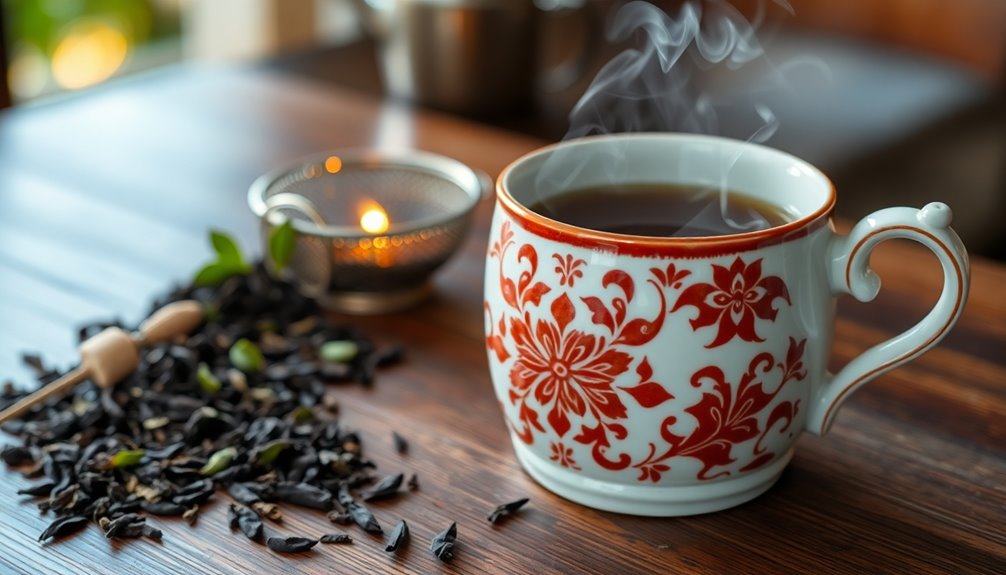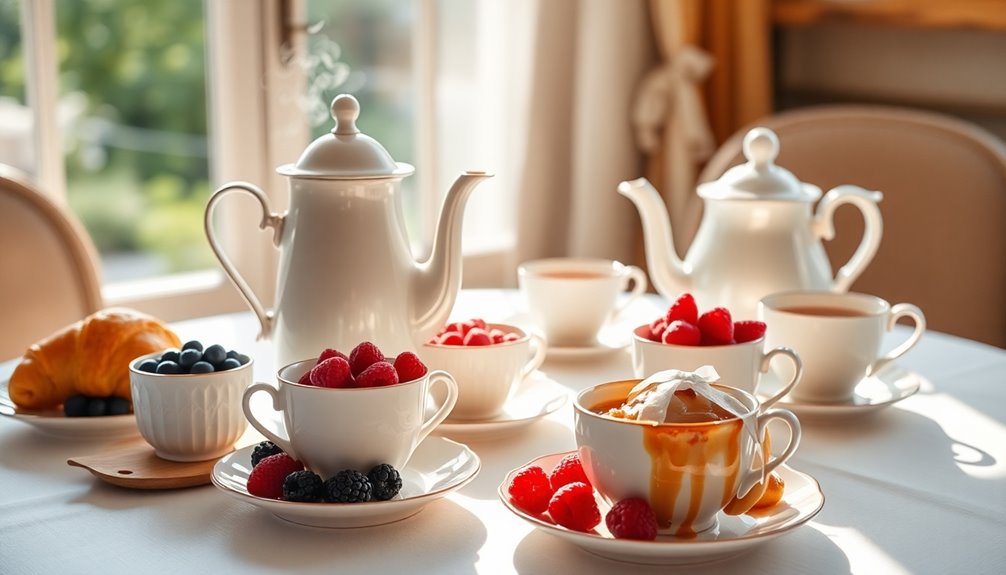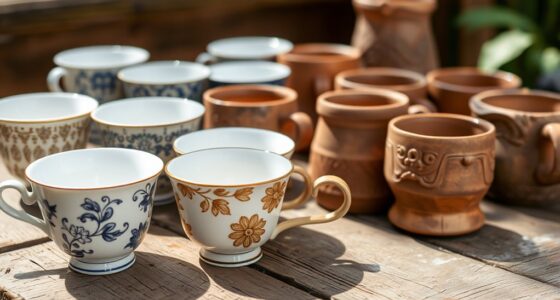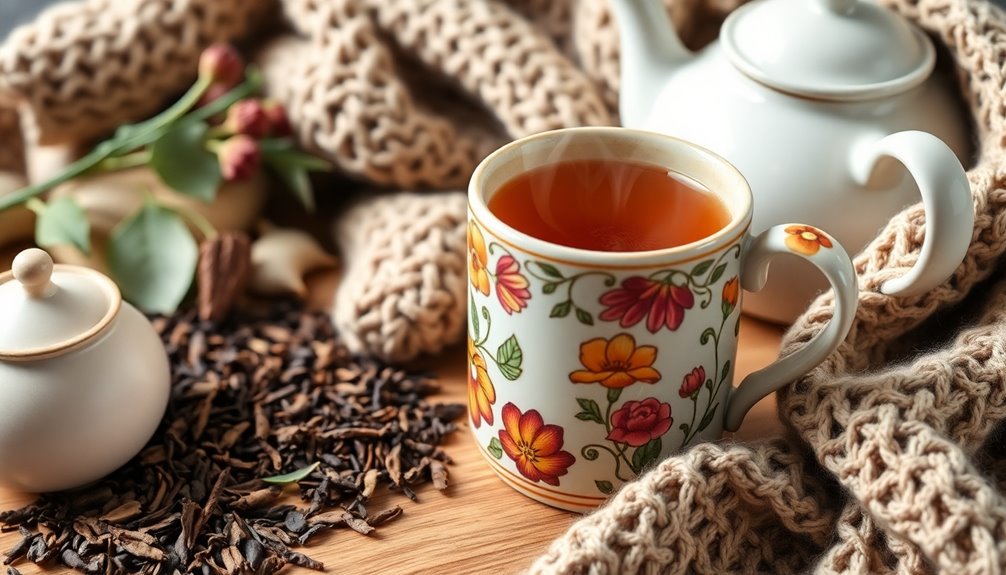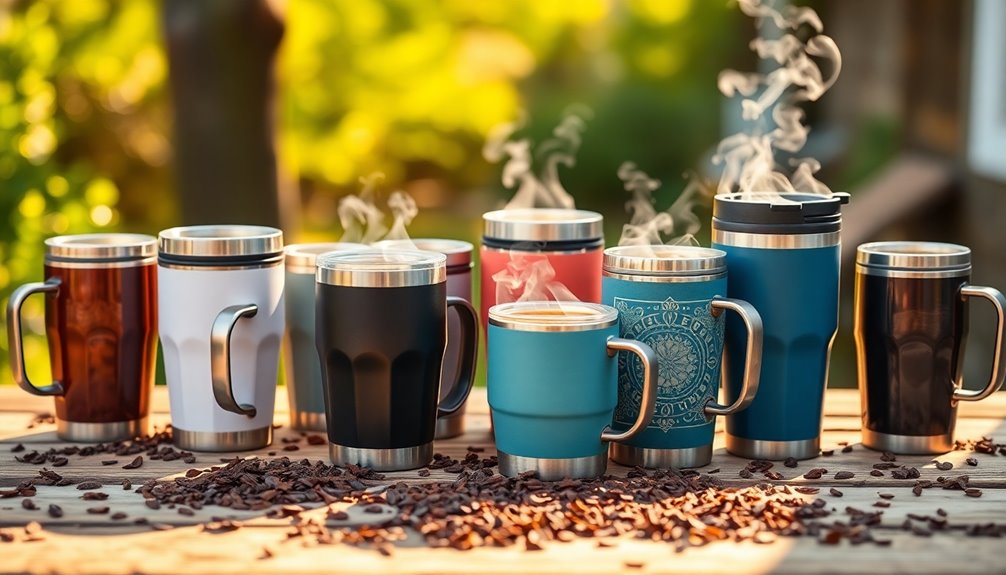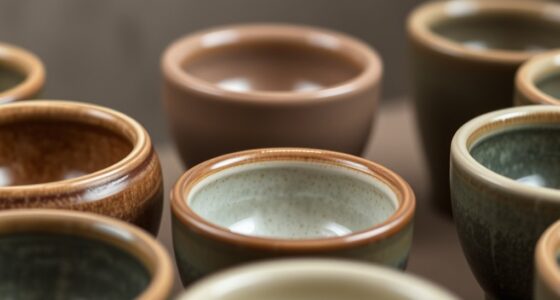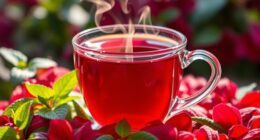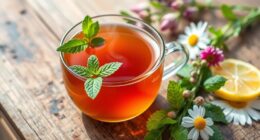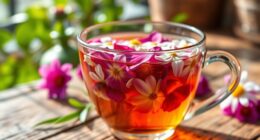When choosing the perfect tea mug, you need to consider material, thermal properties, and design. Non-absorbent materials like ceramic and glass enhance flavor retention, while styrofoam can ruin your tea's taste. The right mug also helps maintain optimal brewing temperatures, crucial for extracting the best flavors from tea compounds. Plus, proper steeping times play a big role in your tea's profile, balancing caffeine content and preventing bitterness. Pay attention to these elements, and you'll elevate your tea experience. Stick around, and you'll discover more ways to refine your tea rituals and enjoy every sip.
Key Takeaways
- The mug material significantly impacts tea flavor, with ceramic and glass being the best choices for non-absorption of flavors.
- Proper brewing temperature is crucial; different teas require specific temperatures to maximize flavor extraction and aroma.
- The right steeping time, around five minutes, helps balance flavor complexity and prevents bitterness from over-extraction of tannins.
- Non-absorbent materials, such as ceramic, enhance the overall tea experience by preserving the tea's aromatic compounds.
- Choosing a mug that maintains temperature can also influence the enjoyment and flavor retention of your tea.
Introduction
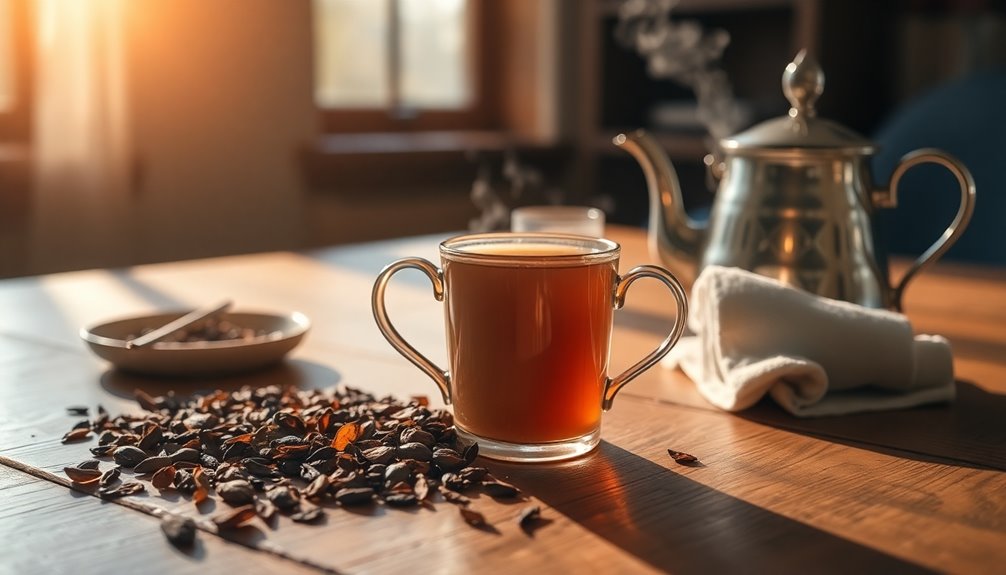
When it comes to enjoying the perfect cup of tea, the right mug makes all the difference. The choice of cup material plays a crucial role in your tea experience. Non-absorbent materials enhance flavor, while styrofoam can absorb flavor molecules, leading to a less satisfying drink.
You also need to consider the design and shape of your mug; these factors affect heat retention, which is vital for maintaining the optimal temperature during brewing. If the mug doesn't hold enough volume, the tea leaves may not have the space they need for proper steeping, hindering flavor extraction.
Pre-warming your mug can further enhance your experience by keeping the tea at the right temperature, allowing the flavors and aromas to fully develop.
Additionally, don't overlook the psychological impact of color; studies suggest that red mugs can make tea taste sweeter compared to white ones. By selecting a mug that meets these criteria—ideal cup material, shape, and color—you'll create an environment that maximizes your tea's flavor potential and overall enjoyment.
Tea's Global Cultural Significance

Tea isn't just a beverage; it embodies rich cultural significance around the world. As the second most consumed drink globally, its importance spans various societies, each with unique customs and brewing techniques.
In China and Japan, tea reflects values of respect and mindfulness, often featured in traditional ceremonies that honor the art of brewing tea.
In the United Kingdom, afternoon tea has evolved into a cherished social ritual, where you enjoy specific food pairings alongside different teas, creating an experience that fosters connection.
Meanwhile, in many Middle Eastern and North African cultures, tea symbolizes hospitality, warmly welcomed as a gesture to guests.
The versatility of tea is remarkable, with each region developing its own flavor profiles and customs, showcasing how this simple drink transcends cultural boundaries.
Whether you're sipping a delicate green tea in a Japanese tea house or indulging in sweet mint tea in Morocco, you're partaking in a global tradition that celebrates community and connection.
Optimal Water Temperature Matters

Brewing tea at the right temperature is crucial for unlocking its full flavor potential. Different types of tea demand specific brewing temperatures to extract the best flavors from the tea leaves.
For instance, you should brew green tea at optimal water temperatures of 160-180°F (70-80°C). This delicate range helps preserve its subtle flavors while avoiding bitterness from tannins.
On the other hand, black tea thrives at higher brewing temperatures, between 200-212°F (93-100°C), allowing for robust flavor extraction and enhanced antioxidant levels.
Using water that's too hot for sensitive teas like white or oolong can lead to a flat taste and a loss of aromatic compounds, ultimately ruining your tea experience.
Maintaining the right water temperature not only maximizes flavor but also ensures a balanced infusion, letting the full spectrum of the tea's characteristics shine through.
So, when you're preparing your next cup, remember that optimal water temperature truly matters. It can be the difference between a bland brew and a delightful, flavorful cup that showcases the unique qualities of each tea variety.
Enjoy your perfect tea mug experience by brewing with care!
Tea's Molecular Flavor Compounds

Understanding the right water temperature not only enhances the brewing process but also sets the stage for appreciating tea's rich molecular flavor compounds. When you brew loose leaf tea, you're tapping into a complex world of flavors driven by various compounds like polyphenols, catechins, and tannins.
These flavor compounds dissolve differently; aromatic ones release quickly, while heavier compounds need longer steeping times for full infusion. The quality of the tea plant plays a crucial role here. If you're using teabags, which often contain smaller leaf pieces, the flavor may be limited compared to whole leaves.
It's essential to strike a balance; over-extracting tannins can make your tea bitter. Moreover, L-theanine, an amino acid found in tea, interacts with caffeine to create a unique flavor profile. This combination promotes relaxation while keeping you alert, unlike the jitters often associated with coffee. Additionally, research shows that certain scents from essential oils can promote relaxation, enhancing the overall tea-drinking experience.
Brewing Time Variations
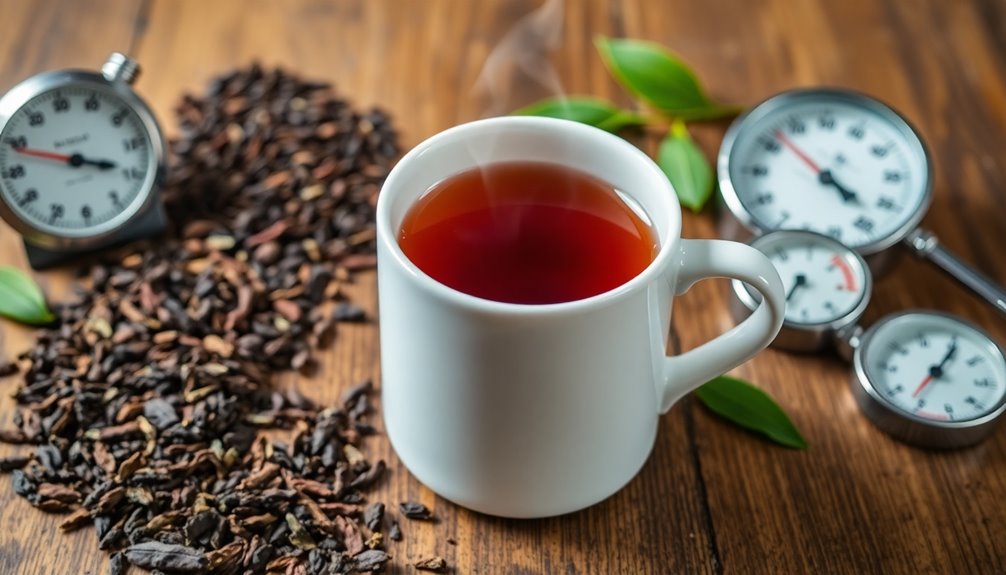
When you steep your tea, even slight variations in brewing time can dramatically alter the flavor and health benefits you experience. The recommended steeping time for optimal flavor extraction is about five minutes. During this period, your tea infuser allows the rich compounds to infuse into the water, creating a well-balanced flavor profile.
If you choose to extend your brewing time, you'll notice an increase in caffeine and antioxidant levels; five minutes can yield about 50 mg of caffeine, compared to just 35 mg after 30 seconds.
However, it's crucial to strike a balance. Over-steeping can lead to excess tannin release, resulting in a bitter taste that overpowers the tea's natural flavors. You want to avoid that bitterness while enjoying the richer and more complex taste that longer steeping can provide.
Practical Applications
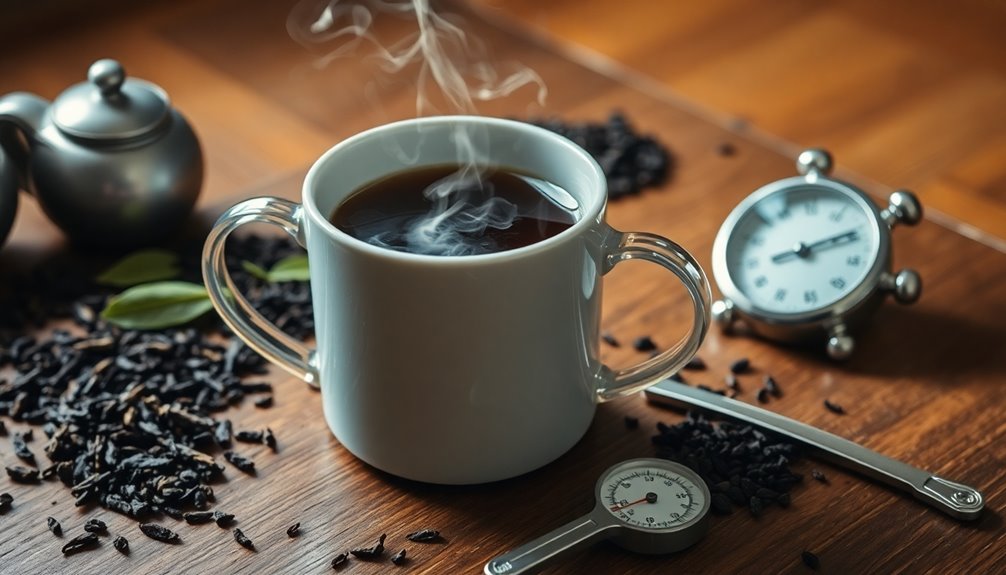
The way you choose and use your tea mug can significantly enhance your overall tea experience. Start by selecting a non-absorbent material for your tea mug; this helps preserve the essential flavor molecules, ensuring you enjoy every sip.
Consider the color of your mug, too—using a red mug may make your tea taste sweeter, thanks to psychological effects.
When it comes to design, opt for a mug with a wider rim. This choice enhances aroma dispersion, enriching your flavor experience as you sip.
If you love your tea piping hot, insulated mugs are your best bet; they keep your tea at the optimal temperature longer, maintaining its intended flavor profile.
Lastly, think about the size of your mug. A larger mug might dilute flavors unless you adjust by adding more tea leaves. If you stick to a smaller size, you can maintain a balanced taste with fewer leaves.
Conclusion
In the end, finding the perfect tea mug isn't just about aesthetics; it's about enhancing your brewing experience. By understanding the importance of water temperature, flavor compounds, and brewing times, you can elevate each cup to new heights. So, whether you're sipping a delicate green tea or a robust black blend, remember that the right mug can make all the difference. Cheers to enjoying your tea rituals with the perfect companion!

